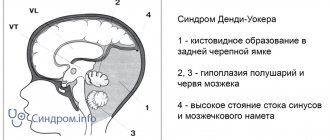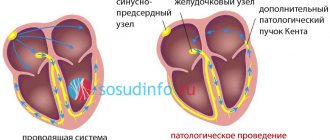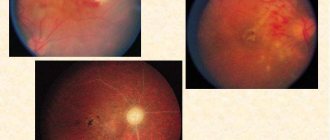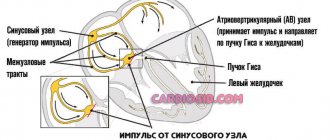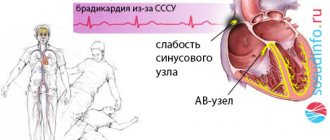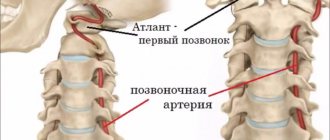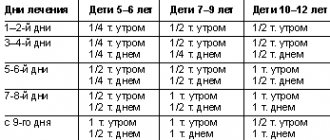© Author: A. Olesya Valerievna, candidate of medical sciences, practicing physician, teacher at a medical university, especially for SosudInfo.ru (about the authors)
Leriche syndrome is a chronic disease in which a narrowing or complete closure of the lumen of the arteries of the legs occurs with impaired circulation. Typically, the pathology is diagnosed in men aged 40-60 years, but in recent years there has been some “rejuvenation” of the group of patients.
The disease is quite dangerous, because it leads to disability in relatively young people, is fraught with fatal complications, and often requires serious surgical treatment. After atherosclerosis of the vessels of the heart and brain, damage to the arteries of the legs takes third place, being detected in almost every fifth patient with atherosclerosis after 50-55 years. In the case of major amputation of a limb, approximately half of the patients are at risk of dying within a year after surgery.
The aorta is the largest vessel in the human body, providing blood to all organs and tissues. In the lower section, it is divided into the right and left iliac arteries, which supply blood to the lower extremities. In Leriche syndrome, the substrate of the disease becomes the lower fragment of the aorta after the renal arteries and iliac vessels depart from it.
Leriche's syndrome. Treatment
Leriche syndrome is a disorder of blood flow in the lower extremities, which occurs when there is severe narrowing or complete blockage of the abdominal aorta at the site of its bifurcation into the iliac arteries. Until recently, the pathology was most often diagnosed in men aged 40-60 years. But doctors warn that she has recently become much younger and her problem is acute even in men aged 30-35 years. Not everyone knows about the existence of such a disease, so doctors often hear the question: “What is Leriche syndrome and what are the chances of getting it?” Answers to questions are in this article.
Diagnosis of the disease
Diagnosis of the disease takes place in several stages.
First, a routine examination of the patient is performed. The doctor collects anamnesis. During the examination, the specialist will try to feel the pulse in the arteries and examine the legs.
Then a laboratory test is ordered. Usually it is aimed at studying such important parameters as glucose levels and lipid spectrum. A coagulogram is also required.
In order to clarify the location and extent of vascular damage, the following methods are used:
- Angiography.
- Vascular ultrasound.
- Aortography with contrast injection.
To assess the functionality of blood vessels, testing is performed on a treadmill.
Additionally, before treatment, the condition of the cerebral arteries and coronary vessels is examined. If they are affected, they will be treated first.
Symptoms and diagnosis of Leriche syndrome
The main signs of the described disease are:
- intermittent lameness;
- problems with potency;
- absence of pulse in the arteries of the lower extremities.
Intermittent claudication is the main symptom of Leriche syndrome. Patients may also experience severe pain in the lower back and buttocks, hips, calf muscles and ankle joints when walking.
Doctors diagnose Leriche syndrome using research methods such as:
- ultrasound examination of the vessels of the lower extremities;
- MRI of the lower extremities;
- contrast angiography.
Main stages of the disease
There are 4 stages of Leriche syndrome:
- Stage 1. At this stage, patients complain of weakness in the legs, slight lameness and chilliness. As a rule, even after a short rest, ailments disappear. For this reason, patients often do not see a doctor. They simply attribute all the symptoms of a dangerous pathology to fatigue.
- Stage 2. The artery narrows more and more. This leads to trophic changes appearing on the skin. Lameness can occur when walking even relatively short distances. Some patients experience discomfort even after walking 200 meters.
- Stage 3. At this stage of the development of the disease, pronounced changes appear on the skin, and pain becomes a constant companion of the patient.
- Stage 4. At this stage, the pain is often unbearable. A large number of ulcers form on the legs, and the tissues undergo necrosis. If treatment is not prescribed, gangrene will develop. Amputation of the leg will be inevitable!
Treatment of Leriche syndrome
Treatment of this disease is carried out therapeutically and surgically. In case of severe damage to the aorta, surgery is inevitable, since gangrene quickly develops with the disease in question, and therefore doctors are forced to amputate the lower limb. It is possible to perform endarterectomy (removal of the substrate that causes the blockage), prosthetics (replacing the affected area of the vessel with a healthy one), bypass surgery (creating a path to resume blood flow bypassing the diseased area), stenting (placement of a special device that does not allow the artery to collapse).
Does surgery guarantee a complete cure for Leriche syndrome? Treatment is also carried out after surgery - the patient must take medications that prevent the formation of blood clots. This therapy can be continued for life.
Surgical treatment of Leriche syndrome does not always lead to complete recovery. So, after amputation the patient becomes disabled. If the patient does not follow the doctors’ recommendations (for example, continues to smoke), the disease may recur with death.
You can be examined for the presence of atherosclerosis of the vessels of the lower extremities and determine the risk of developing Leriche syndrome only at an appointment with a specialist. You can sign up for a consultation on our website https://www.dobrobut.com/.
Treatment
Treatment of Leriche syndrome aims to improve blood flow in the arteries of the legs, prevent the progression of the disease and the development of complications, the most dangerous of which are gangrene, myocardial infarction, and stroke.
Depending on the stage of the disease and the nature of the manifestations, conservative therapy or surgery is prescribed. Conservative treatment includes the prescription of drugs that improve blood circulation in the microvasculature, tissue trophism, and vasodilators.
The patient should know that only treatment prescribed by a doctor will not bring the desired result without excluding risk factors for the disease and lifestyle changes, therefore the main principles of therapy are:
- Elimination of risk factors (control of blood pressure, lipid levels, blood glucose);
- Complete elimination of smoking;
- Regular walks;
- Taking medications to improve blood flow.
Conservative therapy
For stages I and IIA, only conservative treatment is permissible; for more advanced forms, surgery cannot be avoided. Among the drugs prescribed:
- Pentoxifylline, which reduces platelet aggregation and improves the rheological properties of blood. It has been proven that the drug can reduce the symptoms of the disease, but it is effective only in 30-40% of patients;
- Reopoliglucin, reomacrodex, which reduce blood viscosity;
- Acetylsalicylic acid, which prevents thrombosis;
- Cilostazol, which improves blood rheological parameters;
- Ticlopidine, clopidogrel, which have pronounced antiplatelet properties;
- Sulodexide, which reduces viscosity by reducing the content of fats and fibrinogen in the blood;
- Nicotinic acid and its derivatives, which cause dilation of peripheral vessels and promote the breakdown of fibrinogen;
- Antispasmodics (papaverine, drotaverine);
- For severe pain, analgesics are indicated.
For long-term non-healing trophic ulcers, dressings of the affected areas are performed using local agents that improve trophism and regeneration (solcoseryl, methyluracil).
Operation
Surgical treatment is necessary starting from stage IIB of the disease. Before prescribing an operation, the surgeon evaluates the condition of the aorta, vessels of the lower extremities, coronary arteries and cerebral arteries for atherosclerotic lesions and surgical risks associated with it.
For Leriche syndrome, reconstructive operations are performed, the main of which are:
- Endarterectomy – removal of an atherosclerotic plaque with suturing of the vessel or replacement of the defect with synthetic material, native vessels.
- Prosthetics – the altered fragment of the artery is removed, and in its place a synthetic prosthesis or a section of the patient’s vessel taken from another area (autovenous) is installed.
- Aortofemoral bypass surgery - if the lesion is significant, an anastomosis is performed to bypass the damaged area of the vessel (between the aorta and the femoral artery). If the bifurcation of the aorta and both iliac arteries are affected, then a prosthesis is used that completely replaces the site of the bifurcation (in the form of “pants”).
- Stenting – a stent (hollow tube) is installed in a vessel through which blood flows; the method is indicated for patients with damage to the vessels of the heart, brain, or high operational risk when undergoing prosthetics or bypass surgery.
operations for Leriche syndrome – bypass surgery (1) and angioplasty with stenting (2)
If the severity of atherosclerosis is such that it is no longer possible to restore blood flow, or gangrene of the limb has developed, then the only type of operation may be amputation of the leg to a level where blood flow is still present.
It is worth noting that patients who have undergone surgery, as well as those undergoing conservative treatment, must take antiplatelet drugs (aspirin, clopidogrel). In the case of widespread atherosclerosis, such treatment is considered basic and can even be prescribed for life. Vascular drugs are used in courses, and antiplatelet agents are used long-term, throughout life.
Non-drug methods of treating Leriche syndrome consist of ultraviolet and laser irradiation of the blood to reduce its viscosity and reduce platelet aggregation, hyperbaric oxygenation, and physiotherapeutic procedures (UHF, electrophoresis).
Leriche syndrome is a dangerous disease with a serious prognosis. Approximately every third patient who died from cardiovascular pathology has one or another of its manifestations. Prevention of the progression of vascular changes largely depends not only on the timeliness of treatment, but also on the patient’s desire to save the limb and life. Surgeons know of cases where, even after losing a leg, patients did not give up smoking and did not follow the prescribed recommendations. If there are even the slightest signs of impaired arterial blood flow in the vessels of the legs, you should urgently consult a doctor and begin treatment immediately.
Prevention
To prevent Raynaud's disease, medical experts recommend using contrast baths to train blood vessels. It is also necessary to eat properly and nutritiously, and not to overuse coffee, as it constricts blood vessels.
Avoid overheating; in cold weather, always wear gloves and dress appropriately for the weather.
Raynaud's disease should only be treated under the supervision of a qualified physician. You can get quality medical care in.
Saturday Night Paralysis
Many of us have felt numbness and tingling in an arm or leg when sitting in an uncomfortable position for a long time. Such situations happen quite often and usually pass without a trace. But if numbness and tingling are suddenly accompanied by weakness in an arm or leg, then we can say with confidence that nerve damage is developing.
How does Saturday night paralysis occur?
Although Saturday night paralysis sounds poetic, its name is associated with alcohol-abusing bar patrons. It is believed that this term came from the USA, where workers received wages once a week on Saturdays and spent it in bars on drinks. Many of them regularly drank large amounts of alcohol and fell asleep for a long time (all night long) in a certain position “with their face on the table” - i.e. The shoulder was lying on the hard table, and the head was also pressed on top. At the same time, the radial nerve was severely compressed.
The problem is that in the middle third of the humerus, the radial nerve passes shallowly under the skin in a special channel of muscles and ligaments and can be compressed when pressed against a hard surface. With Saturday night paralysis, several negative factors are at work at once: chronic alcohol abuse gradually and steadily damages the nerves, a large dose of alcohol consumed further aggravates the situation, and the radial nerve is compressed for a long time.
However, even if you do not abuse alcohol, such nerve compression can still occur. The risk group includes anyone who has underlying damage to the peripheral nerves (for example, diabetes, brucellosis, rheumatism).
Takayasu's disease (nonspecific aortoarteritis) - symptoms and treatment
Nonspecific aortoarteritis cannot be cured completely. However, with the help of timely and effective treatment, remission can be achieved and the development of deadly complications can be prevented. To do this, you must fully adhere to the prescribed therapy; treatment of the pathology must last at least one year.
Treatment of Takayasu arteritis includes conservative (medicinal) and surgical methods.
Conservative treatment
Drug therapy stops the progression of the disease for some time. The goal of therapeutic methods is to normalize blood pressure, minimize the inflammatory process and specific immune response, restore hemodynamics and eliminate ischemia [15].
There are two main models of treatment: Japanese and American. In Russia, the American model is more often used.
The Japanese model of therapy involves the administration of Prednisolone in the active phase (ESR is constantly 20 mm/h). The dose of Prednisolone does not change for 1–3 months, then the dosage is reduced for 3–12 months. A prerequisite for reducing the dose of Prednisolone is an ESR of less than 20 mm/h.
However, during the first two years after diagnosis, it is not recommended to reduce the dose of the drug below 16 mg/day. Further reduction of the dosage is possible only if the ESR remains constant less than 10 mm/h for 3–6 months.
The drug is discontinued only if there are no signs of exacerbation and if the ESR is normal for a long time. This approach brings good results, including improving blood supply to the extremities in 30% of patients.
The American treatment model also involves prescribing Prednisolone, but according to a different regimen. The dosage is maintained for a month. If the symptoms do not go away for more than a month, the dosage does not change for three months and one of the cytotoxic drugs that suppress the immune system is added: Azathioprine, Methotrexate, Cyclophosphamide (Cyclophosphamide). If the use of these drugs made it possible to reduce the dose of Prednisolone and subsequently discontinue it, then the therapy is considered effective.
The cytotoxic drug must be taken for a year from the moment remission is achieved. If remission occurs, then the dosage of Prednisolone is gradually reduced over 6 months, and in the next 6 months Prednisolone should be noted.
If treatment with Prednisolone does not bring the desired result, Methotrexate is prescribed. Treatment is started with minimal dosages, then gradually increased if there is no intolerance to the drug. In case of intolerance, the dosage is divided into several doses and increased only after 1–2 weeks to the maximum possible tolerated dose.
If, during therapy with Prednisolone and Methotrexate, remission occurs and the ESR values return to normal, a month after the appointment of Methotrexate, it is recommended to reduce the dosage of Prednisolone. When the inflammatory process resumes, Prednisolone is prescribed in the dosage that was prescribed before the relapse. If the dose cannot be reduced 12 months after the start of therapy, an individual alternative treatment regimen is selected.
Cyclophosphamide is not recommended for use due to its toxicity with long-term use.
The biological drug Actemra (Tocilizumab) can be added to conventional immunosuppressive therapy, and it is also used to reduce the total dosage of Prednisolone. The maximum time for using the medicine is 40 months.
A generally accepted protocol for treating Takayasu's arteritis with biological agents has not yet been developed. Side effects and the high cost of treatment force the selection of the minimum effective dosage.
To prevent cardiovascular complications, it is possible to use smaller doses of Acetylsalicylic acid if there are no contraindications.
It is important to remember that lowering blood pressure in patients with significant narrowing of the carotid and vertebral arteries can cause neurological complications.
Surgical treatment
Surgery is recommended if blood pressure is elevated due to renal artery stenosis and if the patient has fibrotic changes in the acute phase [16]. The operation is also performed if life-threatening complications are detected and dysfunction of internal organs and systems develops. Surgery is performed after achieving stable remission.
Extracorporeal hemocorrection. It is performed if the course of the disease is severe, there is no effect of treatment and it is not possible to achieve remission. The patients' blood is cleared of blood clots and circulating immune complexes (CIC), which are formed in the blood when antibodies meet antigens of a foreign agent. Purification is carried out using plasmapheresis and hemosorption. These methods help improve the function of affected organs and restore blood flow.
If treatment does not bring the desired result or gives only a temporary effect, they resort to the help of vascular surgeons. With the help of surgery, you can prevent relapse, as well as restore the patency of the affected vessels as much as possible.
Endarterectomy. It involves the removal of cholesterol plaques from the walls of the arteries. Due to this, it is possible to clean the lumen of the vessel and restore blood flow.
Bypass surgery and endovascular stenting. Bypass surgery is the sewing of a vascular endoprosthesis bypassing a narrowed section of a vessel.
With endovascular stenting, a cylindrical mesh frame is introduced into the lumen of the artery, which mechanically expands the vessel. The technique is used in the fibrotic phase of Takayasu's disease in patients with severe stenosis, arterial hypertension or ischemia.
Angioplasty . A deflated balloon catheter is inserted through a puncture in the femoral or inguinal artery, brought to the site of narrowing and then inflated, due to this the lumen of the artery expands. Percutaneous balloon angioplasty of the aorta normalizes blood pressure and helps restore the pulse in peripheral vessels. As a result, secondary arterial hypertension disappears, as well as congestive heart failure. Full recovery occurs after 3–5 years. Mortality with this treatment does not exceed 10%.
In children with renal artery stenosis and concomitant secondary arterial hypertension, it is possible to perform endovascular stenting. The operation helps normalize blood pressure and reduce the need for antihypertensive drugs.
Benefits of stenting
Leriche syndrome is a dangerous disease. Its treatment should be started immediately after the pathology is detected.
The stenting technique allows for rapid implementation of therapy.
Its advantages include:
- Minimal trauma. The patient can return to normal life within a few days after the operation. This is due to the fact that the intervention is carried out quickly enough and does not involve large incisions. To insert the stent, a small puncture of the soft tissue is sufficient.
- Fast patient recovery. You will only have to stay in the clinic for 1-2 days. With timely intervention, disability is completely eliminated.
- Minimal discomfort. Stenting is performed under local anesthesia. In this case, the patient does not experience pain.
Stages
The clinical picture of the disease involves 4 stages of the disease:
- The first stage is characterized by weakness, chilliness, numbness and burning in the legs, as well as the appearance of lameness after long walks.
- In the second stage, the lumen of the arteries decreases, trophic ulcers form, and the growth of hair and nails is disrupted.
- During the third, the muscles of the lower extremities weaken, pain occurs even at rest.
- The fourth is the most dangerous stage, which is accompanied by multiple ulcers, unbearable pain and necrosis of soft tissues. The patient cannot walk. Amputation is urgently required.
Causes of the disease
Leriche syndrome (another name is aortic atherosclerosis) can be caused by:
- congenital pathologies of the aorta;
- thrombosis;
- nonspecific aortoarteritis;
- blockage of blood vessels;
- atherosclerotic changes in blood vessels;
- dysplasia of the fibromuscular layers of blood vessels.
The causes of atherosclerosis have long been known, these are:
- unhealthy diet (lots of fatty foods, fast food);
- lack of sleep;
- poor lifestyle in general.
Fatty foods have a detrimental effect on the body of the elderly and older people, since their metabolism is slowed down and fats settle on the walls of blood vessels, which leads to atherosclerosis.
Symptoms
Clinical features of Raynaud's syndrome:
- most often, color changes are observed on the fingers;
- changes begin on one finger, then spread to other fingers and become symmetrical on both hands;
- the II-IV fingers of the hands are most often involved, the thumb usually remains unchanged;
- changes in skin color may also be observed in other areas: ears, tip of the nose, face, above the knees;
- during Raynaud's attacks, livedo reticularis may appear on the extremities, which disappears after the completion of vasospasm;
- in rare cases, damage to the tongue is observed, which is manifested by numbness and transient speech impediments.
Clinically, an attack of Raynaud's disease consists of three phases:
- The first phase is expressed in spasm of the arteries, pallor of the skin, a decrease in its temperature, numbness, and pain.
- The second phase is characterized by the development of cyanosis of the skin and increased pain.
- The third phase is swelling and redness of the skin, decreased pain.
However, classic three-phase Raynaud's attacks are observed only in 15% of patients; in most cases, two-phase color changes are observed Source: Alekperov R.T. Raynaud's syndrome in the practice of a rheumatologist / R.T. Alekperov // Modern rheumatology. - 2014. - No. 2. - P. 37-46. .
The duration of the attack is usually 15-20 minutes, but sometimes it can last even several hours.
At the last stage of the disease, persistent skin lesions develop, and deformation of the fingers is possible.
In most cases, Raynaud's disease is symmetrical in nature: if the pathology affects one hand, then after some time the pathology develops on the second.


